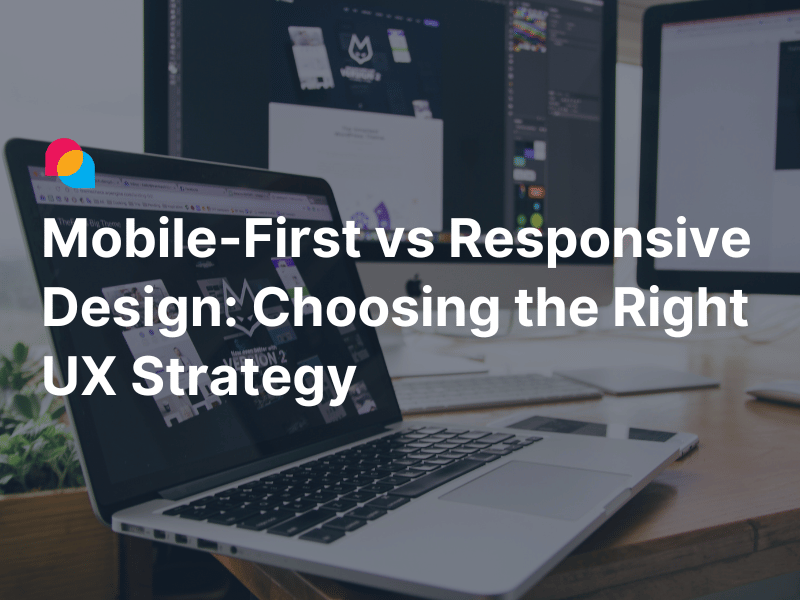In the dynamic world of software development, one element has emerged as crucial to success: User Experience (UX) Design. By focusing on the needs and preferences of users, UX design ensures that software products are not only functional but also enjoyable to use. This article explores the significance of UX design in modern software development and provides a comprehensive guide to leveraging UX principles to create superior software products.
How UX Design Impacts Business Success
The impact of UX design on business success cannot be overstated. Companies that prioritize UX design often see higher customer retention rates, lower support costs, and a stronger brand reputation. By investing in UX design, businesses can differentiate themselves from competitors, attract more users, and foster long-term growth.
Planning for UX Design
Conducting User Research: The Foundation of UX Design
User research is the bedrock of UX design. It involves understanding the needs, behaviors, and motivations of users through various research methods such as surveys, interviews, and observation. This foundational step ensures that the software is tailored to meet user expectations and solve real problems.
Creating User Personas to Guide Development
User personas are fictional characters that represent different user types who might use the software. These personas help developers and designers keep the end-users in mind throughout the development process. By creating detailed personas, teams can ensure that the software addresses the needs and pain points of its intended audience. By incorporating AI analytics, these personas can be dynamically updated based on real-time user data, ensuring that they remain relevant throughout the project lifecycle.
Design Thinking and UX
What is Design Thinking and How It Relates to UX
Design thinking is a problem-solving approach that involves empathy, ideation, and experimentation. It is closely related to UX design as it focuses on understanding and solving user problems. By applying design thinking, software teams can create innovative solutions that provide meaningful user experiences.
Applying Design Thinking in Software Projects
To apply design thinking in software projects, teams need to follow a structured process that includes empathizing with users, defining problems, ideating solutions, prototyping, and testing. This iterative process ensures continuous improvement and refinement of the software product based on user feedback.
Incorporating AI into design thinking involves using predictive analytics to forecast user behavior and preferences. For example, Adobe’s Sensei AI helps designers quickly generate multiple design variations, speeding up the ideation and iteration phases.
UX Design Techniques and Tools
Wireframing and Prototyping: Visualizing Ideas
Wireframing and prototyping are crucial techniques in UX design. Wireframes are basic visual representations of the software's layout and structure, while prototypes are interactive models that simulate the user experience. These tools help designers and developers visualize ideas and test concepts before full-scale development.
The Best Tools for UX Designers in Software Development
There are numerous tools available to assist UX designers in software development. Popular tools include Sketch, Adobe XD, Figma, and InVision. These tools offer a range of features for creating wireframes, prototypes, and high-fidelity designs, facilitating collaboration, streamlining the design process and AI-powered design suggestions
User Journey Mapping: Understanding the User's Path
User journey mapping involves visualizing the steps a user takes to achieve a specific goal within the software. This technique helps identify pain points, opportunities for improvement, and key interactions that influence the user experience. By understanding the user's path, designers can create more intuitive and efficient interfaces.
Tools like UXPressia and Smaply leverage AI to provide deeper insights into user journeys, ensuring a more accurate and comprehensive understanding.
User-Centered Design Approach
The Principles of User-Centered Design (UCD)
User-centered design (UCD) is an approach that prioritizes the needs and preferences of users throughout the development process. The principles of UCD include understanding the user, involving users in the design process, and iterating based on user feedback. This approach ensures that the software meets user expectations and provides a positive experience.
Implementing UCD in Software Development
To implement UCD in software development, teams should engage users early and often. This can be done through user research, usability testing, and feedback sessions. By incorporating user insights into every stage of development, teams can create software that is both user-friendly and effective.
AI-powered tools like IBM Watson can analyze user data to provide actionable insights, making it easier to implement UCD in software development. These tools help teams understand user behavior and preferences, leading to more effective design solutions.
Balancing Business Goals with User Needs
While user-centered design focuses on meeting user needs, it is also important to balance these needs with business goals. Successful UX design aligns user satisfaction with business objectives, such as increasing revenue, improving efficiency, and enhancing brand reputation. By finding this balance, businesses can achieve both user and organizational success.
Usability Testing and Feedback
Conducting Effective Usability Testing
Usability testing involves observing users as they interact with the software to identify usability issues and areas for improvement. Effective usability testing requires a clear plan, representative users, realistic tasks, and careful observation. By conducting usability testing, teams can ensure that the software is intuitive and meets user expectations.
AI-driven usability testing tools like UserTesting and Lookback automate the process of gathering and analyzing user feedback. These tools can identify usability issues and provide actionable insights, making the testing process more efficient and effective.
Interpreting and Acting on User Feedback
Collecting user feedback is only the first step; interpreting and acting on it is equally important. Feedback should be analyzed to identify common themes, prioritize issues, and develop actionable insights. By addressing user feedback, teams can continuously improve the software and enhance the user experience. Sentiment analysis tools like MonkeyLearn help teams prioritize issues based on user sentiment, ensuring that the most critical problems are addressed first.
Iterative Design: Improving Through Continuous Feedback
Iterative design is a process of continuous improvement based on user feedback. It involves making incremental changes, testing, and refining the software over multiple iterations. This approach ensures that the software evolves to meet user needs and remains relevant in a rapidly changing market.
Accessibility in UX Design
Why Accessibility is Crucial in UX Design
Accessibility ensures that software is usable by people with disabilities, providing equal access to all users. It is a crucial aspect of UX design, as it promotes inclusivity and ensures compliance with legal requirements. Accessible software can also reach a broader audience, enhancing user satisfaction and brand reputation.
Designing for Inclusivity: Best Practices
Designing for inclusivity involves following best practices such as providing alternative text for images, ensuring sufficient color contrast, and enabling keyboard navigation. By incorporating these practices, designers can create software that is accessible to users with diverse abilities and needs.
Tools and Techniques for Accessibility Testing
There are various tools available for accessibility testing, including WAVE, Axe, and Lighthouse. These tools help identify accessibility issues and provide recommendations for improvement. By conducting thorough accessibility testing, teams can ensure that their software meets the needs of all users.
AI tools like Microsoft's Accessibility Insights and Axe can automatically detect accessibility issues and provide recommendations for improvement. These tools help designers create inclusive software that meets the needs of all users.
Visual Design Principles
The Role of Visual Design in UX
Visual design is a critical component of UX as it affects how users perceive and interact with software. Effective visual design enhances usability, aids in navigation, and creates a positive first impression. It involves the thoughtful arrangement of elements such as typography, colors, images, and layouts to create an aesthetically pleasing and functional interface.
Key Elements of Effective Visual Design
Effective visual design in UX includes several key elements:
- Typography: The choice of fonts can influence readability and user engagement. Consistent and legible typography helps users process information quickly.
- Color: Colors can evoke emotions and guide user actions. A well-chosen color palette enhances the visual appeal and usability of the software.
- Imagery: Images can make an interface more engaging and provide context. High-quality, relevant images support the overall message and usability.
- Layout: The arrangement of elements should facilitate easy navigation and access to information. A well-structured layout ensures a seamless user experience.
Creating a Consistent Visual Language
Consistency in visual design is crucial for creating a cohesive user experience. This involves using a consistent style for elements such as buttons, icons, and typography across the software. A design system or style guide can help maintain visual consistency, making the software intuitive and easy to use.

Interaction Design
Principles of Interaction Design
Interaction design focuses on creating intuitive and engaging interfaces that facilitate user interactions. Key principles include:
- Feedback: Providing immediate feedback for user actions helps users understand the results of their interactions.
- Simplicity: Simple designs reduce cognitive load and make it easier for users to achieve their goals.
- Consistency: Consistent interactions across different parts of the software help users predict outcomes and navigate more efficiently.
- Affordances: Design elements should suggest their functionality. For example, buttons should look clickable.
Designing Intuitive Interfaces
Intuitive interfaces are easy to use and require minimal learning effort. This can be achieved by adhering to established design conventions, using clear and concise labels, and minimizing unnecessary complexity. User testing is essential to ensure that interfaces are truly intuitive for the target audience. Tools like Protopie and Marvel enable designers to create and test interactive prototypes quickly.
Information Architecture
Building a Strong Information Architecture
Information architecture (IA) involves organizing and structuring content to help users find information efficiently. A strong IA ensures that users can navigate the software easily and locate the information they need without frustration. Key components include clear navigation, intuitive categorization, and effective labeling. Tools like Optimal Workshop use AI to improve content hierarchy and navigation.
Techniques for Effective Content Organization
Effective content organization techniques include:
- Card Sorting: This method involves users grouping content into categories that make sense to them, providing insights into user-friendly organization.
- Tree Testing: This technique tests the hierarchy of the content structure, ensuring that users can find information within the defined structure.
- Wireframing: Creating wireframes helps visualize the layout and organization of content, facilitating better planning and design.
Testing Information Architecture with Real Users
Testing IA with real users involves usability testing methods such as tree testing and card sorting. These methods help identify any issues with content organization and navigation. Feedback from real users ensures that the IA aligns with user expectations and needs.
Responsive and Adaptive Design
Differences Between Responsive and Adaptive Design
Responsive and adaptive design are approaches to creating interfaces that work well on various devices and screen sizes.
- Responsive Design: Uses flexible grids and layouts to adjust seamlessly across different screen sizes.
- Adaptive Design: Uses distinct layouts tailored for specific screen sizes or devices.
Both approaches aim to provide an optimal user experience regardless of the device being used.
Best Practices for Designing Responsive Interfaces
Best practices for responsive design include:
- Fluid Grids: Use flexible grid layouts that scale proportionally to the screen size.
- Flexible Images: Ensure images resize appropriately without losing quality or aspect ratio.
- Media Queries: Use CSS media queries to apply different styles based on screen size, orientation, and resolution.
- Mobile-First Approach: Design for mobile devices first, then scale up for larger screens. This ensures a strong foundation for mobile usability.
AI-driven tools can automate responsive design processes, ensuring that interfaces perform well on all devices. For example, Google's Mobile-Friendly Test uses AI to evaluate and optimize website responsiveness.
Challenges and Solutions in Responsive Design
Challenges in responsive design include ensuring consistent performance across devices, maintaining usability, and managing design complexity. Solutions involve thorough testing on various devices, optimizing assets for performance, and using frameworks like Bootstrap to streamline development. Tools like PageSpeed Insights offer AI-driven solutions to improve load times and user experience across devices.
Emotional Design
Understanding Emotional Design and Its Importance
Emotional design focuses on creating software that evokes positive emotions and connections with users. It goes beyond functionality and aesthetics to consider how users feel while interacting with the software. Positive emotional responses can enhance user satisfaction and loyalty.
Techniques for Creating Emotionally Engaging Experiences
Techniques for emotional design include:
- Storytelling: Incorporating narratives that resonate with users can create a more engaging experience.
- Microinteractions: Small, delightful interactions, like animations and sound effects, can enhance user enjoyment.
- Personalization: Customizing the user experience based on individual preferences makes users feel valued and understood.
Case Studies: Emotional Design in Action
Case studies of emotional design in action include apps like Duolingo, which uses gamification and friendly, encouraging messages to keep users motivated. Another example is the Headspace app, which combines soothing visuals and calming language to create a relaxing user experience.
Performance and UX
How Performance Impacts User Experience
Performance is a critical aspect of UX design. Slow load times, laggy interactions, and unresponsive interfaces can frustrate users and lead to abandonment. Optimizing performance ensures a smooth and enjoyable user experience, leading to higher user satisfaction and retention.
Optimizing Performance for Better UX
To optimize performance for better UX, consider the following:
- Minimize HTTP Requests: Reduce the number of requests made to load resources.
- Optimize Images and Assets: Compress and properly format images to reduce load times.
- Leverage Caching: Use browser and server caching to store frequently accessed data.
- Implement Lazy Loading: Load content only when it is needed, improving initial load times.
AI tools like New Relic and AppDynamics monitor performance and provide real-time optimization suggestions. These tools help ensure that software runs smoothly and efficiently, enhancing the overall user experience.
Tools for Monitoring and Improving Performance
Tools like Google Lighthouse, GTmetrix, and WebPageTest help monitor and analyze performance issues. These tools provide insights and recommendations for optimizing performance, ensuring the software runs efficiently.
Conclusion
UX design is an ongoing journey that evolves with user needs and technological advancements. By staying informed about the latest trends and best practices, businesses can ensure their software remains user-centric and competitive. Embrace UX design as a continuous process, and your software will not only meet but exceed user expectations.





